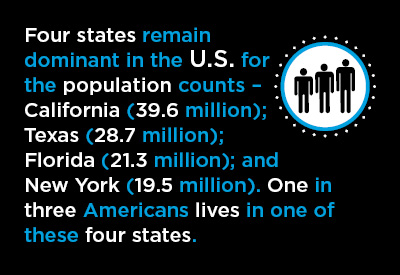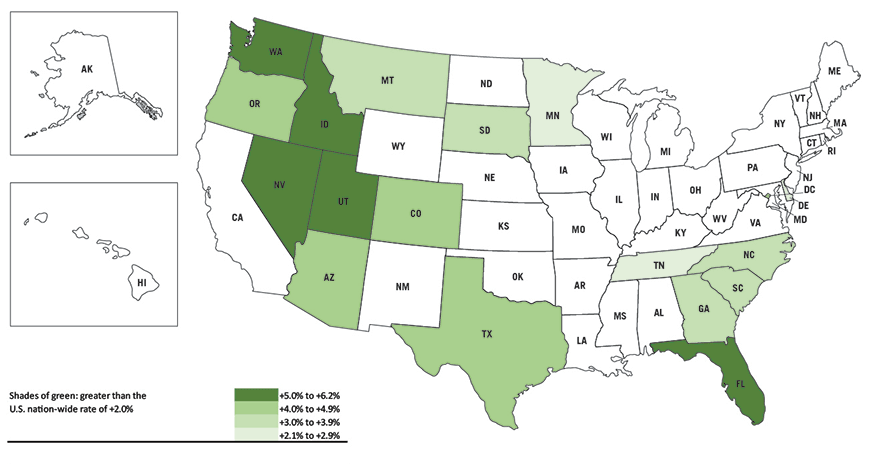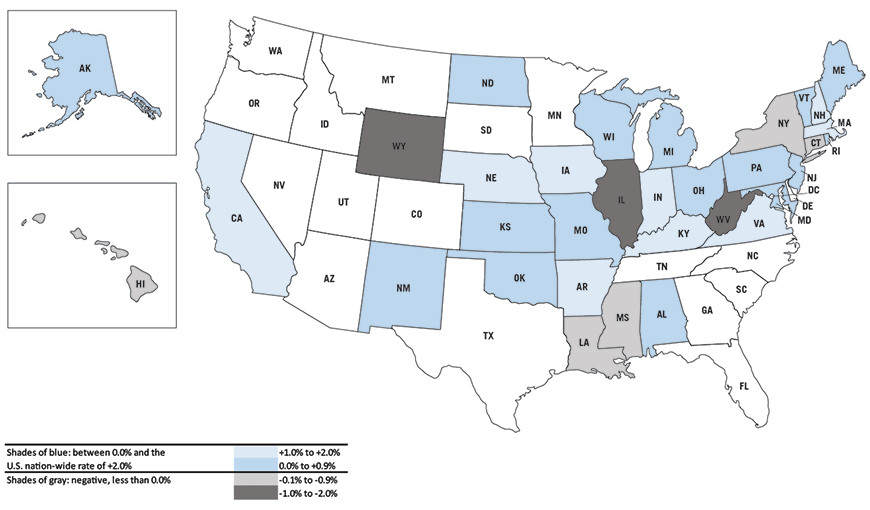The U.S. Census Bureau recently released updated population counts for U.S. states. The date for the official numbers is always July 1 of any given year. Therefore, the latest figures are for July 1, 2018. This article will first set out some of the highlights and then delve into the detail.

Highlights:
(1) Whether year-over-year percentage changes in population are calculated for latest year, latest two years or latest three years, the same three states – Nevada, Idaho and Utah – have led the country.
(2) Over the past three years, two states have added more than one million residents each – Texas and Florida.
(3) Over the past three years, two states have experienced population declines of more than -100,000 each – Illinois and New York; over the past year, those same two states have seen their populations drop by more than -45,000 each.
(4) The latest one-year population change for the entire U.S. has been +0.62%, or +2.0 million people in nominal terms. From a construction point of view, it’s worth noting that an extra couple of million inhabitants is the equivalent of adding two new Metropolitan Statistical Areas (MSAs) to the landscape.
(5) During the latest year, the South and West Regions have tied for fastest population growth, +0.9% each; the Midwest (+0.2%) and Northeast (+0.1%) have experienced only minimal gains.
(6) During the latest year (July 1, 2017 to July 1, 2018), Florida was home to the greatest domestic migration, +133,000.
Detail:
Four states remain dominant in the U.S. for the population counts – California (39.6 million); Texas (28.7 million); Florida (21.3 million); and New York (19.5 million).
With respect to level of population, there is still considerable separation between the front four and fifth-place Pennsylvania (12.8 million), followed by sixth-place Illinois (12.7 million).
One in three Americans lives in one of the four frontrunners. But while Texas, California and Florida are continuing to add citizens, New York is not. New York has shed 119,000 residents over the past three years and nearly 50,000 over the past year alone.
In nominal terms, Texas has been adding more people than Florida over both the latest three years (+1.2 million vs. +1.1 million) and the latest year (+379,000 vs. +323,000). What’s also interesting, though, is that both Texas and Florida have had nominal increases about double what California has encountered.
In percentage terms, the ordering of the big four states has been Florida (+5.3%), Texas (+4.4%), California (+1.6%) and New York (-0.6%) over the past three years (i.e., from July 1, 2015 to July 1, 2018) and Florida (+1.5%), Texas (+1.3%), California (+0.4%) and New York (-0.2%) over the past single year (i.e., from July 1, 2017 to July 1, 2018).
Comparing all states and D.C., Nevada (+5.8% over three years and +2.1% over one year), Idaho (+6.2% and +2.1%) and Utah (+6.0% and +1.9%) have been the brightest lights for population percentage change.
But those three states have relatively small population counts (i.e., slightly over 3.0 million for Utah and Nevada and a little less than 2.0 million for Idaho.) A smaller base makes it easier to achieve a larger percentage-change jump.
Dark-Horse Winners:
It’s the six states with nominal changes (either over the past three years or latest single year) just behind California in the rankings that warrant some special attention. Those six states are: Arizona (+123,000 in latest year), North Carolina (+113,000), Washington (+110,000), Georgia (+106,000), Colorado (+80,000) and South Carolina (+63,000).
Those same six states are also within the Top 15 for percentage changes, whether it be over three years, two years or one year, with Arizona, Colorado and Washington especially strong.
Availability of jobs in cutting-edge/high-tech industries and/or more appealing weather are often the draws that attract population flows. (In turn, population increases translate into all manner of construction undertakings.)
Moving to the opposite end of the spectrum, there have been nine states with population shrinkage over the past year: Mississippi (-0.1%); Wyoming, Louisiana and New York (each -0.2%); Hawaii and Alaska (each -0.3%); Illinois (-0.4%) and West Virginia (-0.6%).
There has been essentially no population change over the latest year in Connecticut, Kansas and Rhode Island.
Maps and Tables:
Accompanying this article are two maps. The first map, with various shades of green (see legend), shows the 17 states, plus District of Columbia, where population growth over the latest three years has been greater than the total U.S. percentage change of +2.0%.
Map 1: U.S. Population – State Comparisons, Ranking by % Change, July 2015 to July 2018
(greater than the nation-wide rate of +2.0%)

Data source: U.S. Census Bureau.
Graphic: ConstructConnect.
The second map, with various shades of blue and gray, shows the 33 states where the rate of population change over the past three years has been either equal to or less than the national figure of +2.0%.
Blue shadings in Map 2 are for states with three-year population changes lying between 0.0% and +2.0%. While advancing more slowly than the ‘green’ states in Map 1, they have still been on the positive side of the ledger.
Gray shadings in Map 2 are for states with negative population change over the latest three years.
Map 2: U.S. Population – State Comparisons, Ranking by % Change, July 2015 to July 2018
(equal to or less than the nation-wide rate of +2.0%)

Data source: U.S. Census Bureau.
Graphic: ConstructConnect.
Also appearing below are six tables ranking states by population levels, nominal changes (one-year and three-year) and percentage changes (one-year, two-year and three-year).
Tables: U.S. States – Population
| Table 2: Ranking by Nominal Change − | |||||||
| Table 1: Ranking by Latest Level | Latest 3 Years | ||||||
| July 1, 2015 | |||||||
| July 1, 2018 | to July 1, 2018 | ||||||
| 1 | California | 39,557,045 | 1 | Texas | 1,215,031 | ||
| 2 | Texas | 28,701,845 | 2 | Florida | 1,075,076 | ||
| 3 | Florida | 21,299,325 | 3 | California | 603,903 | ||
| 4 | New York | 19,542,209 | 4 | Washington | 372,048 | ||
| 5 | Pennsylvania | 12,807,060 | 5 | North Carolina | 350,541 | ||
| 6 | Illinois | 12,741,080 | 6 | Georgia | 338,364 | ||
| 7 | Ohio | 11,689,442 | 7 | Arizona | 338,050 | ||
| 8 | Georgia | 10,519,475 | 8 | Colorado | 243,457 | ||
| 9 | North Carolina | 10,383,620 | 9 | South Carolina | 191,874 | ||
| 10 | Michigan | 9,995,915 | 10 | Tennessee | 179,202 | ||
| 11 | New Jersey | 8,908,520 | 11 | Utah | 178,608 | ||
| 12 | Virginia | 8,517,685 | 12 | Oregon | 173,795 | ||
| 13 | Washington | 7,535,591 | 13 | Nevada | 165,726 | ||
| 14 | Arizona | 7,171,646 | 14 | Virginia | 154,778 | ||
| 15 | Massachusetts | 6,902,149 | 15 | Minnesota | 128,676 | ||
| 16 | Tennessee | 6,770,010 | 16 | Massachusetts | 106,258 | ||
| 17 | Indiana | 6,691,878 | 17 | Idaho | 102,685 | ||
| 18 | Missouri | 6,126,452 | 18 | Indiana | 83,582 | ||
| 19 | Maryland | 6,042,718 | 19 | Ohio | 71,592 | ||
| 20 | Wisconsin | 5,813,568 | 20 | Michigan | 63,342 | ||
| 21 | Colorado | 5,695,564 | 21 | Maryland | 56,001 | ||
| 22 | Minnesota | 5,611,179 | 22 | Missouri | 54,707 | ||
| 23 | South Carolina | 5,084,127 | 23 | Wisconsin | 52,162 | ||
| 24 | Alabama | 4,887,871 | 24 | Kentucky | 42,403 | ||
| 25 | Louisiana | 4,659,978 | 25 | Nebraska | 37,761 | ||
| 26 | Kentucky | 4,468,402 | 26 | New Jersey | 37,651 | ||
| 27 | Oregon | 4,190,713 | 27 | Arkansas | 35,418 | ||
| 28 | Oklahoma | 3,943,079 | 28 | Alabama | 34,711 | ||
| 29 | Connecticut | 3,572,665 | 29 | Iowa | 34,685 | ||
| 30 | Utah | 3,161,105 | 30 | Oklahoma | 33,248 | ||
| 31 | Iowa | 3,156,145 | 31 | Montana | 31,802 | ||
| 32 | Nevada | 3,034,392 | 32 | South Dakota | 28,302 | ||
| 33 | Arkansas | 3,013,825 | 33 | District of Columbia | 27,201 | ||
| 34 | Mississippi | 2,986,530 | 34 | Delaware | 25,758 | ||
| 35 | Kansas | 2,911,505 | 35 | Pennsylvania | 21,301 | ||
| 36 | New Mexico | 2,095,428 | 36 | New Hampshire | 20,164 | ||
| 37 | Nebraska | 1,929,268 | 37 | Maine | 9,920 | ||
| 38 | West Virginia | 1,805,832 | 38 | North Dakota | 6,055 | ||
| 39 | Idaho | 1,754,208 | 39 | New Mexico | 5,217 | ||
| 40 | Hawaii | 1,420,491 | 40 | Kansas | 2,003 | ||
| 41 | New Hampshire | 1,356,458 | 41 | Rhode Island | 1,142 | ||
| 42 | Maine | 1,338,404 | 42 | Vermont | 1,102 | ||
| 43 | Montana | 1,062,305 | 43 | Alaska | -109 | ||
| 44 | Rhode Island | 1,057,315 | 44 | Hawaii | -1,993 | ||
| 45 | Delaware | 967,171 | 45 | Mississippi | -2,163 | ||
| 46 | South Dakota | 882,235 | 46 | Louisiana | -4,873 | ||
| 47 | North Dakota | 760,077 | 47 | Wyoming | -7,931 | ||
| 48 | Alaska | 737,438 | 48 | Connecticut | -14,844 | ||
| 49 | District of Columbia | 702,455 | 49 | West Virginia | -36,164 | ||
| 50 | Vermont | 626,299 | 50 | New York | -119,202 | ||
| 51 | Wyoming | 577,737 | 51 | Illinois | -123,262 | ||
Data source: U.S. Census Bureau.
Tables: ConstructConnect.
| Table 3: Ranking by Nominal Change − | Table 4: Ranking by % Change − | ||||||
| Latest Year | Latest 3 Years | ||||||
| July 1, 2017 | July 1, 2015 | ||||||
| to July 1, 2018 | to July 1, 2018 | ||||||
| 1 | Texas | 379,128 | 1 | Idaho | 6.2% | ||
| 2 | Florida | 322,513 | 2 | Utah | 6.0% | ||
| 3 | California | 157,696 | 3 | Nevada | 5.8% | ||
| 4 | Arizona | 122,770 | 4 | Florida | 5.3% | ||
| 5 | North Carolina | 112,820 | 5 | Washington | 5.2% | ||
| 6 | Washington | 110,159 | 6 | Arizona | 4.9% | ||
| 7 | Georgia | 106,420 | 7 | Colorado | 4.5% | ||
| 8 | Colorado | 79,662 | 8 | Texas | 4.4% | ||
| 9 | South Carolina | 62,908 | 9 | Oregon | 4.3% | ||
| 10 | Nevada | 61,987 | 10 | District of Columbia | 4.0% | ||
| 11 | Tennessee | 61,216 | 11 | South Carolina | 3.9% | ||
| 12 | Utah | 57,987 | 12 | North Carolina | 3.5% | ||
| 13 | Virginia | 52,478 | 13 | Georgia | 3.3% | ||
| 14 | Oregon | 44,121 | 14 | South Dakota | 3.3% | ||
| 15 | Minnesota | 43,024 | 15 | Montana | 3.1% | ||
| 16 | Massachusetts | 38,903 | 16 | Delaware | 2.7% | ||
| 17 | Idaho | 35,304 | 17 | Tennessee | 2.7% | ||
| 18 | Indiana | 31,796 | 18 | Minnesota | 2.3% | ||
| 19 | Ohio | 25,313 | 19 | Nebraska | 2.0% | ||
| 20 | Wisconsin | 21,517 | 20 | Virginia | 1.9% | ||
| 21 | New Jersey | 19,977 | 21 | Massachusetts | 1.6% | ||
| 22 | Michigan | 19,468 | 22 | California | 1.6% | ||
| 23 | Missouri | 17,840 | 23 | New Hampshire | 1.5% | ||
| 24 | Maryland | 17,827 | 24 | Indiana | 1.3% | ||
| 25 | Pennsylvania | 16,613 | 25 | Arkansas | 1.2% | ||
| 26 | Kentucky | 14,528 | 26 | Iowa | 1.1% | ||
| 27 | Alabama | 12,751 | 27 | Kentucky | 1.0% | ||
| 28 | Iowa | 12,508 | 28 | Maryland | 0.9% | ||
| 29 | Nebraska | 11,693 | 29 | Wisconsin | 0.9% | ||
| 30 | Arkansas | 10,828 | 30 | Missouri | 0.9% | ||
| 31 | Oklahoma | 10,439 | 31 | Oklahoma | 0.9% | ||
| 32 | Delaware | 10,093 | 32 | North Dakota | 0.8% | ||
| 33 | Montana | 9,215 | 33 | Maine | 0.7% | ||
| 34 | South Dakota | 8,949 | 34 | Alabama | 0.7% | ||
| 35 | District of Columbia | 6,764 | 35 | Michigan | 0.6% | ||
| 36 | New Hampshire | 6,691 | 36 | Ohio | 0.6% | ||
| 37 | North Dakota | 4,901 | 37 | New Jersey | 0.4% | ||
| 38 | Maine | 3,341 | 38 | New Mexico | 0.2% | ||
| 39 | New Mexico | 2,033 | 39 | Vermont | 0.2% | ||
| 40 | Vermont | 1,774 | 40 | Pennsylvania | 0.2% | ||
| 41 | Rhode Island | 829 | 41 | Rhode Island | 0.1% | ||
| 42 | Kansas | 816 | 42 | Kansas | 0.1% | ||
| 43 | Wyoming | -1,197 | 43 | Alaska | 0.0% | ||
| 44 | Connecticut | -1,215 | 44 | Mississippi | -0.1% | ||
| 45 | Alaska | -2,348 | 45 | Louisiana | -0.1% | ||
| 46 | Mississippi | -3,133 | 46 | Hawaii | -0.1% | ||
| 47 | Hawaii | -3,712 | 47 | Connecticut | -0.4% | ||
| 48 | Louisiana | -10,840 | 48 | New York | -0.6% | ||
| 49 | West Virginia | -11,216 | 49 | Illinois | -1.0% | ||
| 50 | Illinois | -45,116 | 50 | Wyoming | -1.4% | ||
| 51 | New York | -48,510 | 51 | West Virginia | -2.0% | ||
Data source: U.S. Census Bureau.
Tables: ConstructConnect.
| Table 5: Ranking by % Change − | Table 6: Ranking by % Change − | ||||||
| Latest 2 Years | Latest Year | ||||||
| July 1, 2016 | July 1, 2017 | ||||||
| to July 1, 2018 | to July 1, 2018 | ||||||
| 1 | Idaho | 4.2% | 1 | Nevada | 2.1% | ||
| 2 | Nevada | 3.9% | 2 | Idaho | 2.1% | ||
| 3 | Utah | 3.9% | 3 | Utah | 1.9% | ||
| 4 | Washington | 3.3% | 4 | Arizona | 1.7% | ||
| 5 | Arizona | 3.3% | 5 | Florida | 1.5% | ||
| 6 | Florida | 3.2% | 6 | Washington | 1.5% | ||
| 7 | Colorado | 2.8% | 7 | Colorado | 1.4% | ||
| 8 | Texas | 2.7% | 8 | Texas | 1.3% | ||
| 9 | South Carolina | 2.5% | 9 | South Carolina | 1.3% | ||
| 10 | Oregon | 2.4% | 10 | North Carolina | 1.1% | ||
| 11 | District of Columbia | 2.3% | 11 | Oregon | 1.1% | ||
| 12 | South Dakota | 2.2% | 12 | Delaware | 1.1% | ||
| 13 | North Carolina | 2.2% | 13 | South Dakota | 1.0% | ||
| 14 | Georgia | 2.1% | 14 | Georgia | 1.0% | ||
| 15 | Montana | 2.1% | 15 | District of Columbia | 1.0% | ||
| 16 | Delaware | 1.9% | 16 | Tennessee | 0.9% | ||
| 17 | Tennessee | 1.9% | 17 | Montana | 0.9% | ||
| 18 | Minnesota | 1.6% | 18 | Minnesota | 0.8% | ||
| 19 | Virginia | 1.3% | 19 | North Dakota | 0.6% | ||
| 20 | Nebraska | 1.2% | 20 | Virginia | 0.6% | ||
| 21 | Massachusetts | 1.1% | 21 | Nebraska | 0.6% | ||
| 22 | New Hampshire | 1.0% | 22 | Massachusetts | 0.6% | ||
| 23 | California | 0.9% | 23 | New Hampshire | 0.5% | ||
| 24 | Indiana | 0.9% | 24 | Indiana | 0.5% | ||
| 25 | Arkansas | 0.8% | 25 | California | 0.4% | ||
| 26 | Iowa | 0.8% | 26 | Iowa | 0.4% | ||
| 27 | North Dakota | 0.8% | 27 | Wisconsin | 0.4% | ||
| 28 | Wisconsin | 0.7% | 28 | Arkansas | 0.4% | ||
| 29 | Kentucky | 0.7% | 29 | Kentucky | 0.3% | ||
| 30 | Missouri | 0.6% | 30 | Maryland | 0.3% | ||
| 31 | Maryland | 0.6% | 31 | Missouri | 0.3% | ||
| 32 | Maine | 0.5% | 32 | Vermont | 0.3% | ||
| 33 | Alabama | 0.5% | 33 | Oklahoma | 0.3% | ||
| 34 | Ohio | 0.5% | 34 | Alabama | 0.3% | ||
| 35 | Michigan | 0.4% | 35 | Maine | 0.3% | ||
| 36 | Vermont | 0.4% | 36 | New Jersey | 0.2% | ||
| 37 | Oklahoma | 0.4% | 37 | Ohio | 0.2% | ||
| 38 | New Jersey | 0.4% | 38 | Michigan | 0.2% | ||
| 39 | Pennsylvania | 0.2% | 39 | Pennsylvania | 0.1% | ||
| 40 | New Mexico | 0.1% | 40 | New Mexico | 0.1% | ||
| 41 | Rhode Island | 0.0% | 41 | Rhode Island | 0.1% | ||
| 42 | Kansas | 0.0% | 42 | Kansas | 0.0% | ||
| 43 | Mississippi | -0.1% | 43 | Connecticut | 0.0% | ||
| 44 | Connecticut | -0.2% | 44 | Mississippi | -0.1% | ||
| 45 | Louisiana | -0.4% | 45 | Wyoming | -0.2% | ||
| 46 | New York | -0.5% | 46 | Louisiana | -0.2% | ||
| 47 | Hawaii | -0.5% | 47 | New York | -0.2% | ||
| 48 | Alaska | -0.5% | 48 | Hawaii | -0.3% | ||
| 49 | Illinois | -0.7% | 49 | Alaska | -0.3% | ||
| 50 | Wyoming | -1.1% | 50 | Illinois | -0.4% | ||
| 51 | West Virginia | -1.4% | 51 | West Virginia | -0.6% | ||
Data source: U.S. Census Bureau.
Tables: ConstructConnect.











Recent Comments